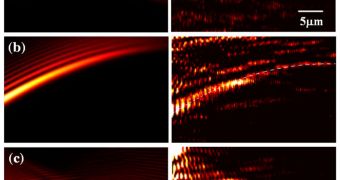Investigators at the US Department of Energy's (DOE) Lawrence Berkeley National Laboratory (Berkeley Lab) announce the development of a new method for exercising dynamic control on the curved trajectories of Airy beams over metallic surfaces.
This new advanced optics study goes against what physics students learn in school, which is that light always travels in a straight line. Though manuals do specify that sometimes light rays fan out of the main beam or diffract as they travel, the main idea is that light cannot change its trajectory.
English astronomer Sir George Biddell Airy – who studied rainbows – lent his name to Airy beams, which are light rays capable of traveling in a curved arc through free space without diffraction.
What the Berkeley Lab team did in the new study was demonstrate that it is possible to set up a mechanism that provides dynamic control of the curved trajectories of Airy beams over metallic surfaces. This is a groundbreaking discovery, and also the first of its kind.
Based on this study and its implications, scientists could soon unlock science-fiction-like technologies, including optoelectronic devices, fast-as-light, ultra-compact communication systems, and other advancements in biology, medicine, physics and chemistry.
In order to achieve success in their experiments, the investigators were able to couple free-space Airy beams with quasi-particles called surface plasmon polaritons (SPP). This was done by using a standard tool of optics called a grating coupler
SPP are created when plasmons (electronic surface waves created by firing lasers on a metal nanostructure) interact with loosely-bound conduction electrons on the surface of the material. In other words, SPP are produced by interactions between plasmons and photons.
The reason why the researchers wanted to couple Airy beams with SPP directly is that this would enable them to manipulate light at scale way below the diffraction limit.
“Dynamic controllability of SPP is extremely desirable for reconfigurable optical interconnections,” explains Berkeley Lab Materials Sciences Division principal investigator and research leader Xiang Zhang.
“We have provided a novel approach of plasmonic Airy beam to manipulate SPP without the need of any waveguide structures over metallic surfaces, providing dynamic control of their ballistic trajectories despite any surface roughness and defects, or even getting around obstacles,” he adds.
“This is promising not only for applications in reconfigurable optical interconnections but also for precisely manipulating particles on extremely small scales,” the expert concludes.
Details of the work appear in the latest issue of the esteemed journal Optics Letters. The study was funded by the US Army Research Office, the US Air Force Office of Scientific Research, and the National Science Foundation Nanoscale Science and Engineering Center.
A .gif image showing how the new system functions can be viewed here.

 14 DAY TRIAL //
14 DAY TRIAL //